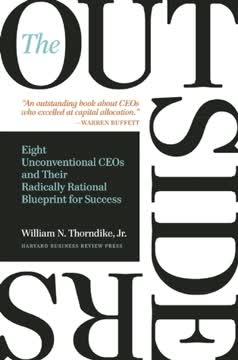Key Takeaways
1. Long-Term Capital Management: Rise and Fall of a Hedge Fund Giant
"In just over four years, an investment in the fund had quadrupled, before accounting for the partners' fees."
Meteoric rise: Long-Term Capital Management (LTCM) was founded in 1994 by John Meriwether, a former Salomon Brothers trader, along with Nobel Prize-winning economists Myron Scholes and Robert Merton. The fund employed complex mathematical models to exploit small price discrepancies in bond markets.
Unprecedented success: LTCM's early years were marked by extraordinary returns:
- 1994: 28% return (20% after fees)
- 1995: 59% return (43% after fees)
- 1996: 57% return (41% after fees)
Spectacular fall: In 1998, a series of market shocks, including the Russian financial crisis, led to massive losses for LTCM. The fund lost $4.6 billion in less than four months, requiring a $3.6 billion bailout orchestrated by the Federal Reserve to prevent a potential systemic financial crisis.
2. The Dangers of Excessive Leverage in Financial Markets
"At the end of 1995, it was leveraged 28 to 1."
Amplified returns and risks: LTCM used enormous leverage to magnify its profits on small price discrepancies. At its peak, the fund had:
- $4.7 billion in equity
- $129 billion in assets
- Over $1 trillion in notional derivative exposure
Unprecedented scale: LTCM's leverage ratios far exceeded industry norms, making it exceptionally vulnerable to market fluctuations. As markets turned against LTCM's positions, this leverage amplified losses, quickly eroding the fund's capital base.
Systemic threat: The fund's massive size and interconnectedness with major financial institutions meant its potential failure posed a significant risk to the broader financial system, prompting the Fed-orchestrated bailout.
3. The Illusion of Risk Control: When Models Fail Reality
"Markets can remain irrational longer than you can remain solvent."
Model limitations: LTCM's sophisticated mathematical models, based on the work of Scholes and Merton, assumed that market behavior followed normal distributions and that past patterns would predict future movements. These assumptions proved dangerously flawed.
Key model failures:
- Underestimating the frequency and magnitude of extreme events ("fat tails")
- Assuming market liquidity would always be available
- Failing to account for the impact of LTCM's own large positions on market dynamics
Reality check: The 1998 Russian financial crisis and subsequent market turmoil exposed the limitations of LTCM's risk models. Events that the models deemed virtually impossible occurred, leading to catastrophic losses.
4. The Human Factor: Hubris and Overconfidence in Trading
"You take Monica Lewinsky, who walks into Clinton's office with a pizza. You have no idea where that's going to go," Conseco's Max Bublitz, who had declined to invest in Long-Term, noted. "Yet if you apply math to it, you come up with a thirty-eight percent chance she's going to go down on him. It looks great, but it's all a guess."
Intellectual arrogance: LTCM's partners, particularly Larry Hilibrand and Victor Haghani, displayed extreme confidence in their models and strategies, often dismissing concerns raised by others.
Psychological traps:
- Confirmation bias: Interpreting new information to confirm existing beliefs
- Overconfidence: Underestimating risks and overestimating abilities
- Groupthink: Suppressing dissenting views within the firm
Ignoring warning signs: Despite mounting evidence of market instability and increasing risks, LTCM's partners remained committed to their strategies, even increasing their bets in some areas.
5. Market Liquidity: A Fair-Weather Friend
"Liquidity is a coward, it disappears at the first sign of trouble."
The liquidity mirage: LTCM's strategies relied heavily on the assumption that markets would remain liquid, allowing them to easily enter and exit positions. This assumption proved catastrophically wrong during the 1998 crisis.
Liquidity spiral:
- Market stress causes traders to reduce risk
- Reduced risk-taking leads to less liquidity
- Less liquidity causes further market stress
- The cycle repeats, amplifying market moves
LTCM's dilemma: As liquidity dried up, the fund found itself unable to unwind its massive positions without causing further market disruptions, trapping it in a downward spiral of losses.
6. Systemic Risk: The Interconnectedness of Global Finance
"Markets would . . . possibly cease to function."
Financial contagion: The 1998 crisis demonstrated how seemingly unrelated market events (e.g., Russian default) could rapidly spread across global financial markets, affecting a wide range of assets and institutions.
Network effects:
- LTCM's counterparties included most major Wall Street firms
- The fund's failure threatened to create a domino effect of losses
- Concerns about counterparty risk led to a broader credit crunch
Regulatory blind spots: LTCM's near-collapse exposed significant gaps in financial regulation, particularly regarding hedge funds and over-the-counter derivatives markets.
7. The Role of Central Banks in Financial Crises
"To be sure, some moral hazard, however slight, may have been created by the Federal Reserve's involvement."
Fed intervention: The Federal Reserve, led by William McDonough, orchestrated a $3.6 billion bailout of LTCM by a consortium of 14 financial institutions. This action was taken to prevent potential systemic disruption to financial markets.
Debate over central bank role:
- Pros: Prevented potential market meltdown, maintained financial stability
- Cons: Created moral hazard, potentially encouraging future risk-taking
Policy implications: The LTCM crisis sparked discussions about the need for greater oversight of hedge funds and the potential risks posed by highly leveraged financial institutions.
8. The Aftermath: Lessons Learned and Unlearned
"The partners appeared to accept responsibility; they said they did and apologized on various occasions; but they never made clear just what it was they were apologizing for."
Immediate impact:
- Increased scrutiny of hedge funds and their strategies
- Reevaluation of risk management practices across the financial industry
- Discussions about the need for greater regulation of derivatives markets
Long-term consequences:
- Continued debate over "too big to fail" and moral hazard in financial markets
- Ongoing challenges in effectively regulating complex financial instruments
- Persistent issues with excessive leverage and risk-taking in parts of the financial sector
Unlearned lessons: Despite the LTCM debacle, many of the underlying issues that contributed to the crisis – excessive leverage, overreliance on models, and the potential for systemic risk – continued to play roles in subsequent financial crises, including the 2008 global financial crisis.
Last updated:
FAQ
What's When Genius Failed about?
- LTCM's rise and fall: The book details the story of Long-Term Capital Management (LTCM), a hedge fund founded by financial elites, including Nobel laureates. It explores how LTCM's innovative strategies initially led to extraordinary profits but ultimately resulted in a catastrophic collapse.
- Financial crisis implications: It highlights the interconnectedness of global financial markets and the risks posed by complex financial instruments, particularly derivatives. The narrative serves as a cautionary tale about the dangers of excessive leverage and the hubris of financial experts.
- Lessons from history: Roger Lowenstein uses LTCM's story to illustrate broader themes in finance, such as market efficiency, risk management, and the unpredictability of financial markets.
Why should I read When Genius Failed?
- Insight into financial markets: The book provides a detailed examination of the hedge fund industry and the mechanics of financial markets, making it valuable for anyone interested in finance or investing.
- Cautionary tale: LTCM's story serves as a warning about the potential consequences of overconfidence and the failure to recognize risk. Readers can learn from the mistakes made by LTCM's partners.
- Engaging narrative: Lowenstein's writing is accessible and engaging, blending storytelling with financial analysis, making it an enjoyable read for both finance professionals and general readers.
What are the key takeaways of When Genius Failed?
- Risk management importance: The book emphasizes the necessity of understanding and managing risk, particularly in leveraged investments. LTCM's downfall illustrates how ignoring potential risks can lead to catastrophic losses.
- Market efficiency myth: Lowenstein challenges the notion that markets are always efficient, showing how irrational behavior can lead to significant mispricings.
- Interconnectedness of markets: The narrative highlights how events in one market can have ripple effects across the globe, underscoring the importance of considering systemic risk in financial decision-making.
What are the best quotes from When Genius Failed and what do they mean?
- "Markets can remain irrational longer than you can remain solvent.": This quote by John Maynard Keynes underscores the unpredictability of markets and the dangers of over-leveraging.
- "In a strict sense, there wasn’t any risk—if the world had behaved as it did in the past.": This reflects LTCM's reliance on historical data to predict future outcomes, highlighting the flaw in assuming that past performance guarantees future results.
- "The essence of the Black-Scholes formula is that you know, with certainty, not what the deal of the cards will be but what kind of universe is being sampled.": This quote illustrates the theoretical underpinnings of LTCM's strategies, emphasizing the belief in predictable market behavior.
What was Long-Term Capital Management (LTCM)?
- Hedge fund overview: LTCM was a hedge fund founded in 1994 by John Meriwether, featuring a team of highly educated traders, including Nobel laureates Robert Merton and Myron Scholes.
- Initial success: LTCM achieved remarkable returns in its early years, earning 28% in its first year and 59% in its second.
- Collapse and impact: Despite its early success, LTCM collapsed in 1998 due to excessive leverage and exposure to market volatility, leading to a financial crisis that required intervention from the Federal Reserve.
What is arbitrage, as discussed in When Genius Failed?
- Definition of arbitrage: Arbitrage is the practice of taking advantage of price differences in different markets or forms of an asset.
- LTCM's strategy: LTCM specialized in relative value arbitrage, betting on the convergence of prices between related securities, such as government bonds.
- Risks of arbitrage: While often seen as a low-risk strategy, LTCM's experience demonstrated that it can still involve significant risks, particularly when leverage is used.
How did LTCM use leverage, and what were the consequences?
- Leverage explained: Leverage involves borrowing capital to increase the potential return on investment. LTCM leveraged its capital by borrowing extensively.
- High leverage ratios: At its peak, LTCM operated with leverage ratios exceeding 28 to 1, meaning it controlled $28 in assets for every $1 of its own capital.
- Consequences of excessive leverage: When market conditions turned against LTCM, its losses were amplified by its leverage, leading to a rapid decline in its capital.
What role did derivatives play in LTCM's strategies?
- Definition of derivatives: Derivatives are financial contracts whose value is derived from the performance of an underlying asset, such as stocks, bonds, or commodities.
- LTCM's use of derivatives: LTCM employed derivatives extensively to manage risk and enhance returns, using complex contracts to bet on price movements.
- Risks associated with derivatives: While derivatives can provide flexibility and leverage, they also introduce significant risks, particularly when used in large volumes.
How did LTCM's collapse affect the financial system?
- Systemic risk concerns: LTCM's collapse raised alarms about systemic risk in the financial system, as its interconnectedness with major banks meant its failure could have widespread repercussions.
- Federal Reserve intervention: In September 1998, the Federal Reserve organized a bailout involving major Wall Street banks to prevent a broader financial crisis.
- Long-term implications: The fallout from LTCM's collapse led to increased scrutiny of hedge funds and derivatives, as well as calls for greater regulation in the financial industry.
What led to the collapse of Long-Term Capital Management?
- Overreliance on models: LTCM's strategies were heavily based on mathematical models that failed to account for extreme market conditions.
- Excessive leverage: The fund operated with a leverage ratio of up to 100-to-1, which magnified its losses when trades went against it.
- Market panic and liquidity crisis: As LTCM began to incur losses, other market participants reacted by selling off similar positions, exacerbating the fund's problems.
How did the Federal Reserve respond to LTCM's crisis?
- Intervention to prevent systemic risk: The Federal Reserve intervened to orchestrate a private-sector bailout of LTCM to prevent a broader financial crisis.
- Formation of a consortium: The Fed facilitated the creation of a consortium of major banks that would invest in LTCM to stabilize the fund.
- Criticism of the Fed's actions: The Fed's involvement raised questions about moral hazard and the implications of bailing out private hedge funds.
What lessons can be learned from When Genius Failed?
- Need for risk management: The LTCM saga underscores the importance of robust risk management practices in financial institutions.
- Importance of diversification: While LTCM believed it was diversified, its positions were highly correlated, serving as a reminder of the need for true diversification.
- Awareness of market psychology: Understanding the psychological factors that drive market behavior is crucial, as panic and fear can lead to irrational selling.
Review Summary
When Genius Failed recounts the rise and fall of Long-Term Capital Management, a hedge fund that collapsed in 1998. Readers praise Lowenstein's engaging storytelling and clear explanations of complex financial concepts. The book highlights LTCM's reliance on flawed mathematical models and excessive leverage, drawing parallels to the 2008 financial crisis. Many reviewers find the story captivating and relevant, noting its lessons on risk management and market behavior. Some criticize the abundance of technical details, while others appreciate the thorough examination of LTCM's strategies and downfall.
Similar Books










Download PDF
Download EPUB
.epub digital book format is ideal for reading ebooks on phones, tablets, and e-readers.







